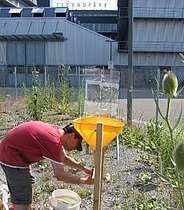The number of people living in urbanised areas is steadily increasing - in Switzerland too. Urban areas also harbour diverse forms of nature, ranging from indigenous vegetation, semi-natural habitats and parks to wasteland and other highly human-influenced habitats. Our understanding of social and cultural values, biodiversity and the quality of life in urban areas must be investigated if we hope to develop sustainable urban environments that will lessen their ecological footprint in future.
Objectives ¶
The main goal of the project was to understand the relationship between urban diversity, built environment and the acceptance of the human population, in order to identify initial measures for integrating findings on how to enhance urban biodiversity and the acceptance of the residents into urban development processes.
Methods ¶
The research plan consisted of 4 modules:
- Collecting historical and recent information in an international context in order to assess potential biodiversity in the built environment
- Assessing the ecological value of urban habitats by collecting data systematically in 3 Swiss cities
- Interviews in the study areas - representative of the whole of Switzerland - to investigate the attitudes of residents towards green urban habitats
- Synthesis and practical implementation
Significance ¶
The findings are important in improving the decision-making basis of political and practical intervention to maintain and improve biodiversity, as well as their acceptance as part of the urban development process.

